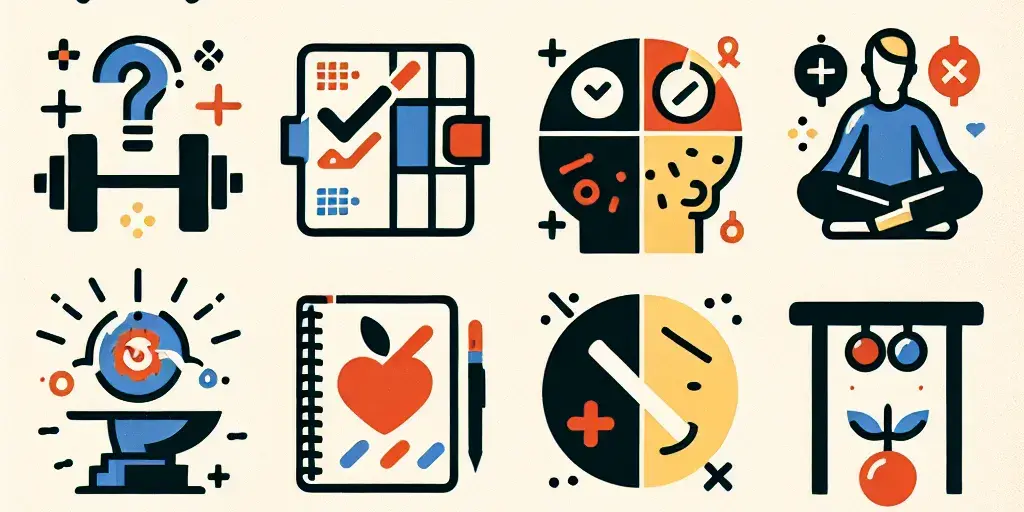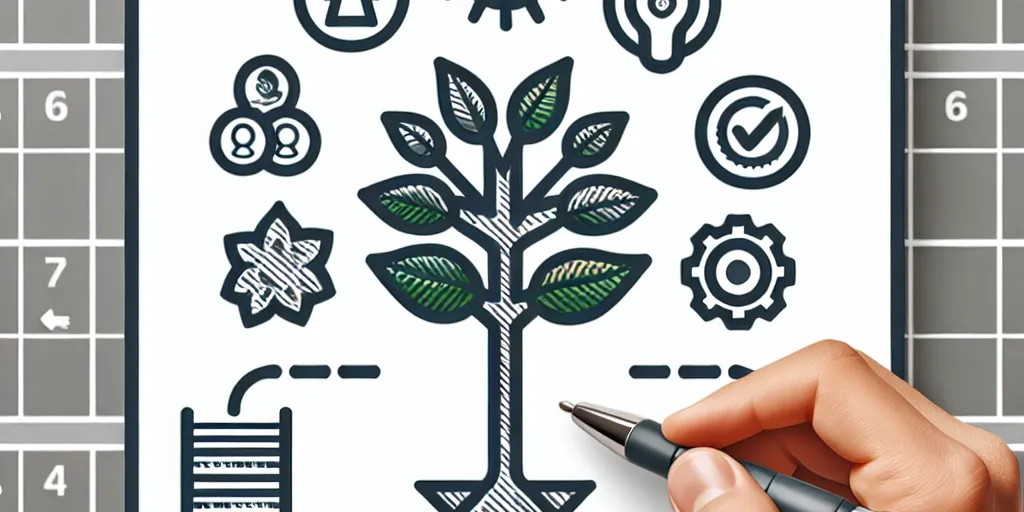· Seren Marlowe · productivity and time management · 15 min read
Conquer Delays: 10 Ways to Stop Procrastinating Today!
Bid Farewell to Procrastination

We’ve all been there—staring at a task with the best of intentions, yet distraction seems to be our closest companion. Procrastination is a common foe that pads quietly into our lives, often leaving us feeling frustrated and unaccomplished. But fear not! Incorporating these 10 ways to stop procrastinating into your life can flip the script on your old habits. By understanding the reasons behind our tendency to delay and employing strategic approaches to overcome it, you can start to make meaningful progress in your work and life.
Let’s take a peek at the actionable strategies that will set the stage for a more productive you. Each section is tailored to help you build momentum and say goodbye to procrastination for good.
- Understanding Procrastination
- Setting Realistic Goals
- The Role of Time Management
- Creating a Productive Environment
- The Pomodoro Technique: A Timer-Based Approach
- Finding Your Motivation
- Dealing with Distractions
- The Importance of Self-Reward
- Getting Started: Taking the First Step
- Maintaining Momentum
Understanding Procrastination
Before we can tackle procrastination head-on, it’s essential to understand what it truly is. Procrastination isn’t just a harmless habit of postponing tasks; it’s often a symptom of something deeper. It exists at the crossroads where the human brain’s preference for instant gratification battles with our need for long-term achievement.
At its core, procrastination is a coping mechanism. We use it to deal with discomfort associated with certain tasks—be it boredom, anxiety, self-doubt, or a fear of failure. The task you’re avoiding might feel overwhelming, or you might not see its immediate value. So, in an attempt to feel better, you delay. That relief, however, is fleeting, and soon the stress of unfinished work looms larger than ever.
But it’s not just about the unpleasantness of the task at hand. Procrastination also has a lot to do with how we perceive time. We are much better at acknowledging the needs and rewards of our present selves than we are at looking out for our future selves. When you procrastinate, you’re prioritizing the ‘now’ over the ‘later’—despite knowing that ‘later’ will eventually become ‘now’.
Understanding procrastination is pivotal because it builds a foundation for change. By recognizing the emotional triggers and time perspectives that lead to procrastination, you can employ the forthcoming 10 ways to stop procrastinating more effectively. Self-awareness is the first step towards personal growth, and as you become more attuned to the whys behind your hesitation, you’ll be better equipped to tackle the hows of moving forward.
Setting Realistic Goals
 Setting goals is a fundamental part of overcoming procrastination. However, the key here is to set realistic goals that are attainable and motivating without being overwhelming. Think of your goals as stepping stones to success—each one should be actionable and lead you toward your ultimate objective. Here’s how to set goals that will encourage you rather than deter you:
Setting goals is a fundamental part of overcoming procrastination. However, the key here is to set realistic goals that are attainable and motivating without being overwhelming. Think of your goals as stepping stones to success—each one should be actionable and lead you toward your ultimate objective. Here’s how to set goals that will encourage you rather than deter you:
Be Specific: Vague goals can lead to vague results. Define exactly what you want to accomplish. Instead of ‘work on project’, try ‘complete the project outline’ or ‘research three potential suppliers’.
Make Them Measurable: You should be able to track your progress. Having measurable goals allows you to see how far you’ve come and how far you have to go.
Ensure They’re Achievable: Setting a goal that’s too ambitious can be just as demotivating as setting no goal at all. Consider your resources and constraints to ensure your goals are within reach.
Be Relevant: Your goals should align with your values and long-term objectives. If a goal doesn’t contribute to your broader aspirations, it may be a distraction.
Time-Bound: Attach deadlines to your goals. Knowing that there’s a finite amount of time to achieve something can propel you into action.
By setting goals that are specific, measurable, achievable, relevant, and time-bound (SMART), you create a roadmap that provides direction and fosters a sense of achievement. This, in turn, helps maintain momentum and keeps the shadow of procrastination at bay.
The Role of Time Management
In our quest to conquer procrastination, time management is a non-negotiable ally. It’s about more than just planning our day; it’s about allocating our most limited resource—time—in a way that maximizes productivity and balances work with rest. If you’ve ever felt like there aren’t enough hours in the day, effective time management can help you reclaim control.
The key is not to prioritize what’s on your schedule, but to schedule your priorities. Here’s how the role of time management plays into overcoming procrastination:
Prioritize Tasks: Not all tasks are created equal. Understand the importance of each task and tackle them in order of priority. This means sometimes saying no to tasks that do not serve your main objectives.
Plan Ahead: Take time at the beginning of each day or week to plan out what needs to be done. A clear plan removes ambiguity, which often leads to procrastination.
Use Tools: Embrace calendars, apps, or traditional planners. Tools that help manage your time can offer a visual representation of how your days are allocated, making it easier to see where your time is being spent.
Set Boundaries: Allocate specific times for work and rest. By setting these boundaries, you’re more likely to be productive during work hours and genuinely relax during your downtime.
Reflect and Adjust: Regularly reflect on how you’re spending your time. If you find that certain activities are consuming disproportionate amounts of your day, it could be time to make some changes.
Remember, time management isn’t about filling every moment with tasks. It’s about creating a balance that allows you to be productive without burning out. As you improve your time management skills, you’ll notice that the temptation to procrastinate diminishes, and you’re able to make more intentional choices with the time you have.
Creating a Productive Environment
Your environment has a profound impact on your productivity levels and your likelihood to procrastinate. It can either be a sanctuary of focus or a nest of distractions. Creating a productive environment is an essential step in curbing the procrastination habit and fostering a space where concentration can flourish.
Let me share a personal experience that highlights this: There was a time when I constantly found myself avoiding tasks, and after some reflection, I realized my cluttered desk and noisy surroundings were partly to blame. Once I decluttered, organized my workspace, and added some noise-cancelling headphones to the mix, my ability to focus skyrocketed, and the lure of procrastination weakened significantly.
Here are some ways to craft an environment that encourages productivity and reduces the temptation to procrastinate:
Declutter Your Space: A tidy workspace can lead to a clear mind. Keep only what you need within reach to minimize physical distractions.
Control the Noise: Some people thrive on background noise, while others need complete silence. Figure out what works best for you and make it happen, whether it’s through a white noise machine, earplugs, or a serene playlist.
Optimize Your Comfort: Adjust your chair, lighting, and other aspects of your environment to find the right balance. Discomfort can lead to restlessness and procrastination.
Establish ‘Do Not Disturb’ Signals: This could be as simple as a sign on your door or an agreement with those around you that when you’re at your desk, you’re off-limits unless there’s an emergency.
By taking control of your physical space and crafting it to serve your needs, you’ll set the stage for success. Remember, the aim is to design an environment that minimizes the pull of procrastination and maximizes your potential for undisturbed work.
The Pomodoro Technique: A Timer-Based Approach
 The Pomodoro Technique is a time management method that can help you power through distractions, hyper-focus, and get things done in short bursts, while taking frequent breaks to come up for air and relax. Named after the Italian word for ‘tomato’ due to the tomato-shaped kitchen timer its inventor, Francesco Cirillo, used, this technique has stood the test of time, helping countless people beat procrastination and boost productivity.
The Pomodoro Technique is a time management method that can help you power through distractions, hyper-focus, and get things done in short bursts, while taking frequent breaks to come up for air and relax. Named after the Italian word for ‘tomato’ due to the tomato-shaped kitchen timer its inventor, Francesco Cirillo, used, this technique has stood the test of time, helping countless people beat procrastination and boost productivity.
Here’s the gist of it: when faced with any large task or series of tasks, you break the work down into short, timed intervals (called ‘Pomodoros’) that are spaced out by short breaks. Here’s how to implement it:
Choose a Task: Pick a task you’d like to get done—something that deserves your full attention.
Set the Timer: Traditionally, pomodoros are 25 minutes long, but some find that 20 or even 15 minutes work best for them.
Work on the Task: Work on the task until the timer rings. If a distraction pops into your head, write it down, but immediately get back on task.
End Work When the Timer Rings: Put a checkmark on a piece of paper to note what you’ve completed.
Take a Short Break: After every pomodoro, take a five-minute break. This helps your brain assimilate the information and rest before the next round.
Longer Break After Four Pomodoros: Once you’ve completed four pomodoros, take a longer break, between 15 to 30 minutes.
Do more and have fun with time management.
— Francesco Cirillo
The magic of the Pomodoro Technique lies in its simplicity and the clear structure it provides, which can turn vast lakes of time into navigable channels. By dividing your workflow into manageable chunks of effort, it helps maintain a rhythm that can discourage procrastination and keep your brain fresh and focused.
Finding Your Motivation
Finding your motivation is often the most integral step in overcoming procrastination. Understanding why you want to accomplish your tasks can provide a strong incentive to push through the lack of desire to do something. After all, motivation is what gets you started; habit is what keeps you going.
Let’s put it into perspective with a personal story: I used to struggle with getting up early to exercise. It wasn’t until I seriously considered the reasons behind my goal—like wanting to improve my health and energy levels—that I found the motivation to change my routine. With those motivating factors clear in my mind, waking up for a morning jog became not just a possibility, but a priority.
Connect to Your Why: Remind yourself of the reasons behind your tasks. Whether it’s to advance in your career, learn a new skill, or improve your health, keeping your ‘why’ at the forefront can spur you into action.
Visualization: Picture the positive outcomes of completing your tasks. Imagine the sense of accomplishment and the benefits that will follow.
Find Accountability: Sometimes, sharing your goals with a friend or joining a like-minded community can provide the external push needed to get moving.
Reward Yourself: Setting up a reward system can create tangible motivation. Treat yourself to something enjoyable after completing a task or reaching a milestone.
Finding what uniquely motivates you may require some self-reflection, but once tapped into, it can be a powerful force against the habit of procrastination, lighting a fire under even the most mundane tasks.
Dealing with Distractions
 Distractions are the archenemies of focus, and in our connected world, they are more abundant than ever. From the pings of social media notifications to the lure of just one more episode on our favorite streaming service, distractions can sidetrack even the strongest wills. Learning how to deal with distractions is crucial for maintaining productivity and keeping procrastination at bay.
Distractions are the archenemies of focus, and in our connected world, they are more abundant than ever. From the pings of social media notifications to the lure of just one more episode on our favorite streaming service, distractions can sidetrack even the strongest wills. Learning how to deal with distractions is crucial for maintaining productivity and keeping procrastination at bay.
I once had a big project looming over me, and instead of tackling it, I found myself endlessly tidying my workspace and checking emails. That’s when I realized that these distractions were a comfort zone—familiar and easy compared to the mountain of work I feared to climb. Once I acknowledged this, I took concrete steps to eliminate those distractions, and my productivity soared.
Here are ways to help minimize the impact of distractions:
Identify Your Distractions: Be honest about what typically pulls your attention away from work. Once identified, you can take steps to eliminate or reduce these distractions.
Create a Distraction-Free Zone: Establish a physical space where you do nothing but work. This is a ‘no distraction’ zone.
Use Technology Wisely: Turn off unnecessary notifications and use app blockers during work hours.
Structure Your Day: Have specific times for checking emails and social media, so you’re not tempted to look at them every few minutes.
Mindfulness and Self-Control: Sometimes, it’s about training your mind. Pause and ask yourself if what you’re about to do will serve your goals.
By proactively managing your environment and honing your self-discipline, you can create a space where concentration can thrive, and distractions become a non-issue. The key is to remember that every moment of focused work is a step away from procrastination and toward your success.
💡 Positivity is contagious in a delightful way—it’s like a social sunshine spreading warmth. Research shows that sharing positive experiences with others not only boosts your mood but also creates a positive ripple effect, uplifting those around you. So, smile often; you never know how many days you might brighten!
The Importance of Self-Reward
An often overlooked aspect in the battle against procrastination is the importance of self-reward. It’s based on a simple premise: when we know a reward is waiting for us at the end of a task, we’re more inclined to push through to the finish line. This is not just about indulgence; it’s about creating positive reinforcement that can help build productive habits over time.
Rewards can serve as powerful motivators, especially when tackling less appealing tasks. The psychology behind it is tied to dopamine, a neurotransmitter associated with feelings of pleasure and satisfaction. Completing a task followed by a reward can lead to the release of dopamine, which not only makes you feel good but also encourages you to repeat the productive behavior.
Here’s how you can effectively use self-reward to stop procrastinating:
Choose Meaningful Rewards: The reward should be something you genuinely look forward to and don’t ordinarily allow yourself to have.
Break It Down: Pair smaller rewards with smaller accomplishments and larger rewards with more significant milestones.
Timely Rewards: Don’t delay gratification too long. You want the reward to be associated closely with the completion of the task.
We are what we repeatedly do. Excellence, then, is not an act, but a habit.
— Aristotle
Remember, the reward system is not about bribery; it’s a tool for building a series of positive experiences linked with the tasks you want to accomplish. By reinforcing your achievements with rewards, you’re not only more likely to complete tasks but also to build an ingrained desire to tackle future tasks with enthusiasm and less procrastination.
Getting Started: Taking the First Step
The journey of a thousand miles begins with a single step. It’s a cliché, yes, but within it lies a profound truth, especially when it comes to Getting Started: Taking the First Step. Procrastination often roots itself in the sheer intimidation of beginning. By focusing on this very first action, you minimize the obstacle that ‘starting’ presents and pave the way for continued progress.
Here’s how you can encourage yourself to take that all-important first step and keep moving forward:
Simplify the Task: Break down the task into the smallest possible step. Instead of ‘write a report’, start with ‘write the first sentence’.
Create a Starting Ritual: Develop a simple routine that signals your brain it’s time to work. It could be making a cup of tea, arranging your work tools, or a few minutes of deep breathing.
Use Verbal Commitment: Tell yourself out loud, ‘I will work on this for just ten minutes.’ Often the hardest part is just beginning; once you start, you’ll likely keep going.
Visualize the Process: Not just the end result, but the act of working. By visualizing yourself taking the steps, you’re mentally preparing for the task.
Eliminate the Non-Essential: Clear away anything that isn’t necessary for the task at hand. This helps to reduce decision fatigue and the number of potential distractions.
By focusing on that very first step, the rest of the journey often falls into place. Encouraging yourself to start can be just the nudge needed to sidestep procrastination and take a confident stride towards your goals.
Maintaining Momentum
Once you’ve started on your path and are making progress, maintaining that forward motion—or Maintaining Momentum—becomes your next challenge. Momentum has this magical quality where the more you keep at it, the easier it becomes to continue. Like a ball rolling down a hill, as your progress builds, so does the energy propelling you forward.
Here are key strategies to help you maintain momentum and ensure that your initial efforts are sustained over time:
Set Clear Milestones: Having specific, intermediate goals can give you a continuous sense of achievement. Celebrate these little victories to motivate yourself towards your final goal.
Stay Organized: Keep your action items, notes, and schedules tidy. Organizational chaos can halt momentum quickly.
Adjust as Needed: Be prepared to adapt your strategy if you’re not seeing the progress you hoped for. Flexibility can keep you moving forward when obstacles arise.
Consistency Over Intensity: It’s better to work consistently at a sustainable pace rather than in unpredictable, intense bursts. Regular effort tends to build better habits.
Reflect on Your Progress: Regular reflection allows you to appreciate how far you’ve come and plan the next steps effectively.
Stay Connected to Your Why: Remind yourself why you started and what you’re working towards. This can be a powerful way to maintain your drive.
Energy and persistence conquer all things.
— Benjamin Franklin
Momentum is both a result of your actions and a catalyst for future success. By leveraging these strategies to keep your momentum going, you’re not just sticking to your tasks, you’re building an ecosystem that’s conducive to productivity and low on procrastination.
💡 Motivation can be enhanced by setting specific, challenging goals. The brain responds to such objectives with increased focus and determination, releasing neurotransmitters that fuel a sense of accomplishment. Clear goals not only provide direction but also trigger a powerful motivational response in the brain.
Although overcoming procrastination is a journey that requires consistent effort, the rewards of productivity and peace of mind are well worth it. By applying these tips and being patient with yourself, you’ll find that tasks become less daunting and your goals more attainable. Remember, every small step counts towards your larger journey of personal development.





